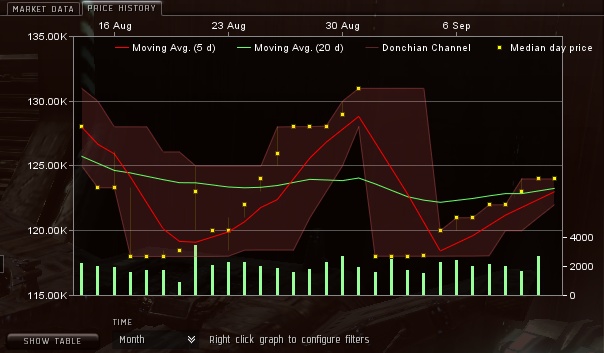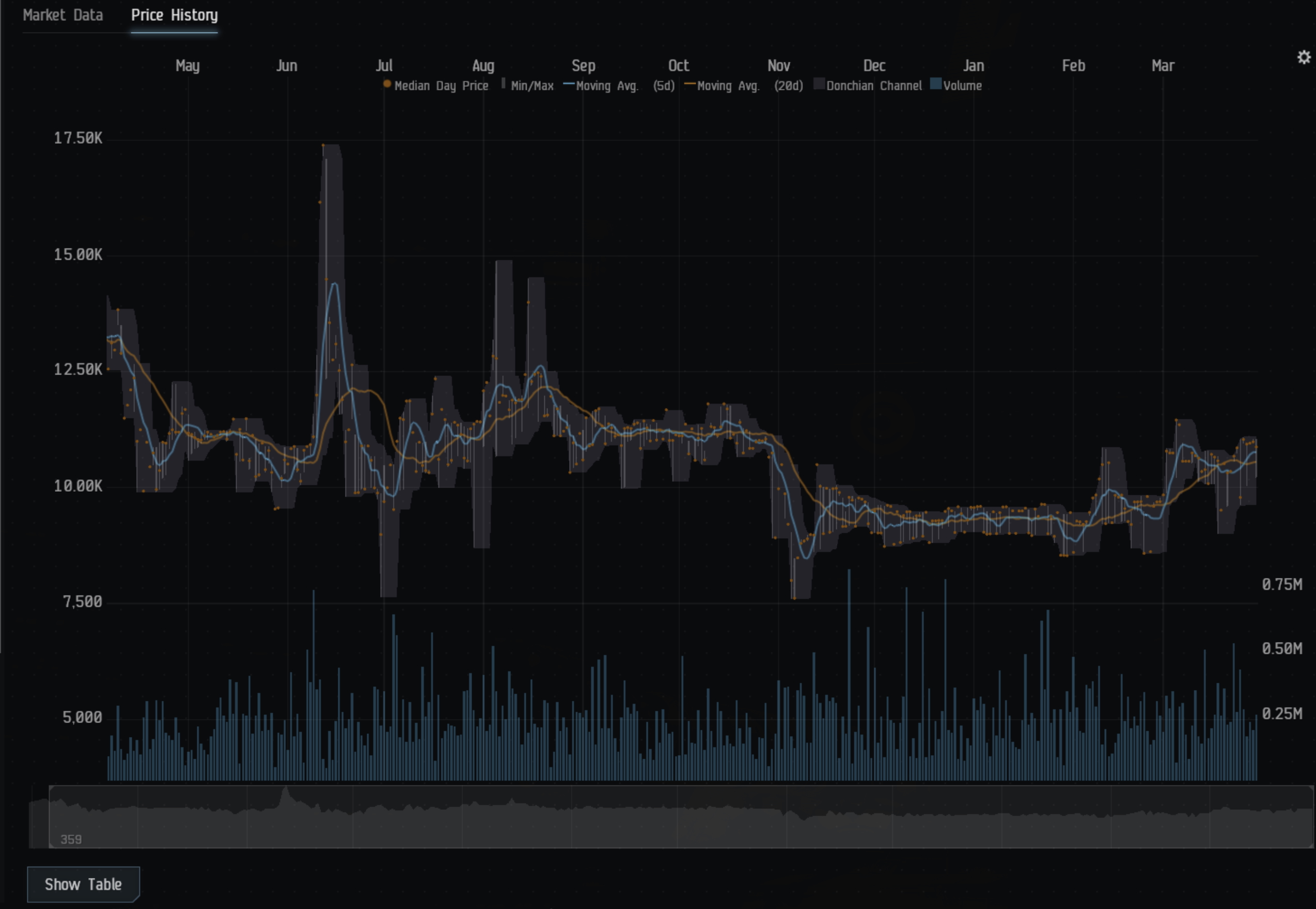Difference between revisions of "Identifying items for trade"
Altim Barr (talk | contribs) m (Pictures linked properly!) |
(Minor formatting) |
||
| Line 1: | Line 1: | ||
| − | As there are a lot of trading classes going up, I'd like to start a thread for trading "rules of thumb", so to speak. Specifically, how to identify a potentially profitable product. I'm going to share a quick trick I've used to get about 2.5b ISK in 3 months of active trading, ie. checking orders for 30min once or twice a day. | + | As there are a lot of trading classes going up, I'd like to start a thread for trading "rules of thumb", so to speak. Specifically, how to identify a potentially profitable product. I'm going to share a quick trick I've used to get about 2.5b ISK in 3 months of active trading, ie. checking orders for 30min once or twice a day. |
| − | It's called the Bullworth Burger. | + | It's called the '''Bullworth Burger'''. |
This is how you use the Bullworth Burger: | This is how you use the Bullworth Burger: | ||
| − | + | #Open the Market window | |
| − | + | #Click on a random product that you might be interested in trading | |
| − | + | #Show the Price History tab | |
| − | + | #Look for Good Burger Characteristics, and add to your market quickbar if you see them | |
| − | + | #Repeat 2-4 until you have a good list of potential products | |
| − | + | #Start trading! | |
| − | What are Good Burger Characteristics? | + | === What are Good Burger Characteristics? === |
Basically, you want items that: | Basically, you want items that: | ||
| − | + | #'''Trade in large volume.''' This is more important if you have smaller amounts of isk, as you want quick turnover, but it is generally a positive thing. This is the "Guacamole on the Side" - green bars on the bottom. The more guacamole, the better. | |
| − | + | #'''Have good profit margins.''' People sell it for a bit of quick cash, but are willing to pay a lot more to buy it. This is the "patty", or big brown shape, representing the highest and lowest sell/buys. The thicker the patty, the better. | |
| − | + | #'''Are used, replaced, and discarded often.''' This is represented by a middle-of-the-road Median price. This ensures you can accumulate and sell inventory with some regularity. "Mustard in the Middle" - represented by yellow squares in the middle of the graph. The mustard should be in the middle of the "patty" as often as possible. This means supply and demand is somewhat balanced. The yellow square indicates the median price - that is, half of the orders occurred above that price, and half below. Generally speaking, a high order "pushes" the yellow box down, a low order "pushes" it up. | |
| − | + | #'''Given the above, are relatively steady in their pricing.''' "Lettuce and Ketchup" - green and red lines. Lettuce leaves are straight for the most part, indicating good stability. Ketchup is best spread around, so should be a jagged line moving up and down, indicating short-term price fluctuations, which helps you acquire items for less and sell them for more. | |
| − | |||
| − | |||
| − | |||
| − | |||
| − | |||
| − | |||
| − | |||
| − | |||
| − | |||
| − | |||
| − | |||
| − | |||
So in summary, look for items that have heaps of Guacamole, big thick Patties, Mustard in the Middle, and straight Lettuce and jagged Ketchup. There's no bread. When you have found some potential items, figure out which items will fit into your working capital and available trading slots, then region buy and sell away. | So in summary, look for items that have heaps of Guacamole, big thick Patties, Mustard in the Middle, and straight Lettuce and jagged Ketchup. There's no bread. When you have found some potential items, figure out which items will fit into your working capital and available trading slots, then region buy and sell away. | ||
Revision as of 23:38, 8 October 2009
As there are a lot of trading classes going up, I'd like to start a thread for trading "rules of thumb", so to speak. Specifically, how to identify a potentially profitable product. I'm going to share a quick trick I've used to get about 2.5b ISK in 3 months of active trading, ie. checking orders for 30min once or twice a day.
It's called the Bullworth Burger.
This is how you use the Bullworth Burger:
- Open the Market window
- Click on a random product that you might be interested in trading
- Show the Price History tab
- Look for Good Burger Characteristics, and add to your market quickbar if you see them
- Repeat 2-4 until you have a good list of potential products
- Start trading!
What are Good Burger Characteristics?
Basically, you want items that:
- Trade in large volume. This is more important if you have smaller amounts of isk, as you want quick turnover, but it is generally a positive thing. This is the "Guacamole on the Side" - green bars on the bottom. The more guacamole, the better.
- Have good profit margins. People sell it for a bit of quick cash, but are willing to pay a lot more to buy it. This is the "patty", or big brown shape, representing the highest and lowest sell/buys. The thicker the patty, the better.
- Are used, replaced, and discarded often. This is represented by a middle-of-the-road Median price. This ensures you can accumulate and sell inventory with some regularity. "Mustard in the Middle" - represented by yellow squares in the middle of the graph. The mustard should be in the middle of the "patty" as often as possible. This means supply and demand is somewhat balanced. The yellow square indicates the median price - that is, half of the orders occurred above that price, and half below. Generally speaking, a high order "pushes" the yellow box down, a low order "pushes" it up.
- Given the above, are relatively steady in their pricing. "Lettuce and Ketchup" - green and red lines. Lettuce leaves are straight for the most part, indicating good stability. Ketchup is best spread around, so should be a jagged line moving up and down, indicating short-term price fluctuations, which helps you acquire items for less and sell them for more.
So in summary, look for items that have heaps of Guacamole, big thick Patties, Mustard in the Middle, and straight Lettuce and jagged Ketchup. There's no bread. When you have found some potential items, figure out which items will fit into your working capital and available trading slots, then region buy and sell away.
Disclaimer: There is just a method of evaluating items, as it focuses on trading behaviour, but may not work for everyone or in every region. Finding a good trading and pricing strategy is best learned by doing, and is far beyond the scope of the Bullworth Burger.
Fig 1.1 - Good Volume, Volatile Buy/Sell, Little Profit The checklist: Good Guacamole, and with somewhat stable lettuce and an oscillating tomato. The mustard dots are all over the place, indicating mostly days of extremely heavy selling (dot near the top of the patty), with some days of very heavy buying. You can probably buy this item on one day, then sell it the next day or week, but it's not reliable. Furthermore, assuming a 2% fee from your orders, buying at a low of 117k and selling at a high of 130k, that's only about a 10k profit per item. In recent days, you would buy at 117k and sell at 120k, at a loss, most likely. Hardly worth your time. So, too little patty on this one.
Note: Due to the heavy buying of this item I would assume it's a consumable that producers are actively marketing. This means that not only will you be competing with other traders, but with industry types as well.
Fig 1.2 - Good Volume, Stable, ~15% profit, plenty of ISK movement The checklist: Good guacamole - even if only 40 units are moved per day, it's stable and at 20m/trade that's about a 800m ISK daily market. Lettuce is nice and flat with the tomato moving smoothly up and down. The patty is nice and thick, for the most part, and the mustard is almost always in the middle of the patty, but towards the bottom. This means that capsuleers are offloading to traders slightly faster than they are buying, so you will probably acquire faster than you can sell. One strategy to mitigate this is to haul or use courier contracts to move your bought stuff to busier hubs.
The patty indicates a 2.5m profit per item in recent days, which is about 12%. After fees, 10%. Not a superstar, but decent if you have the ISK and prefer slower turnover (less maintenance on orders) and reliable demand/supply.

